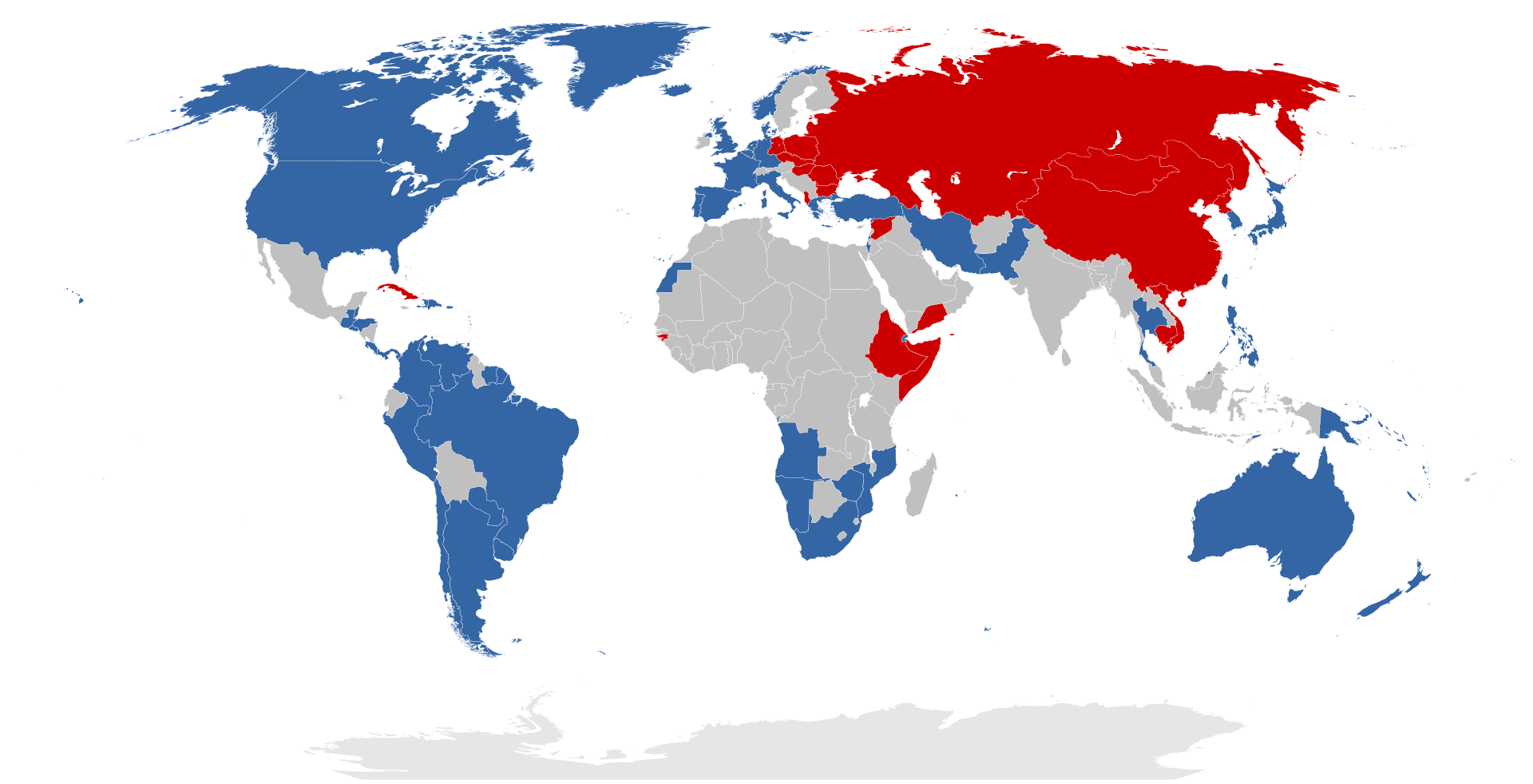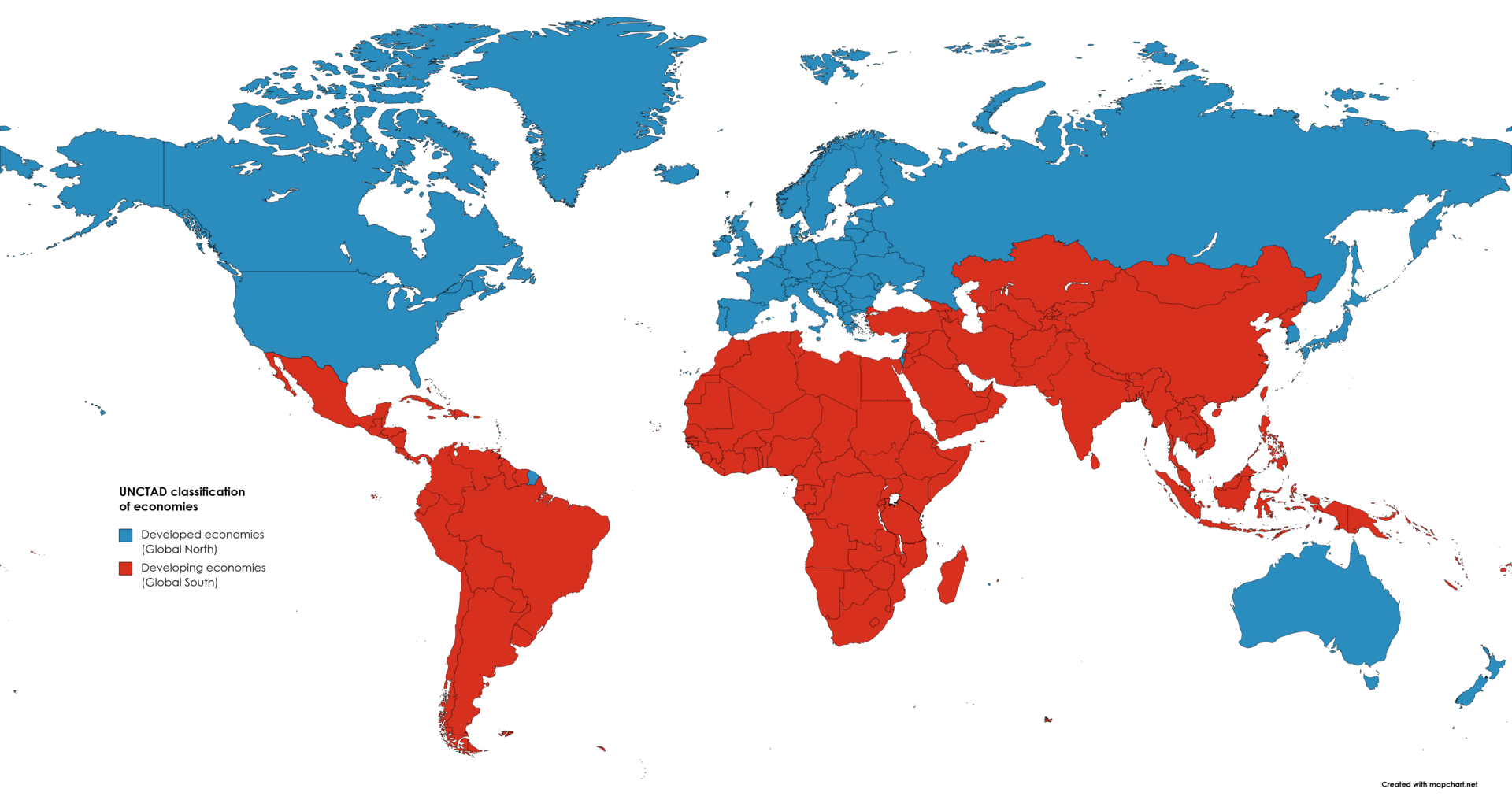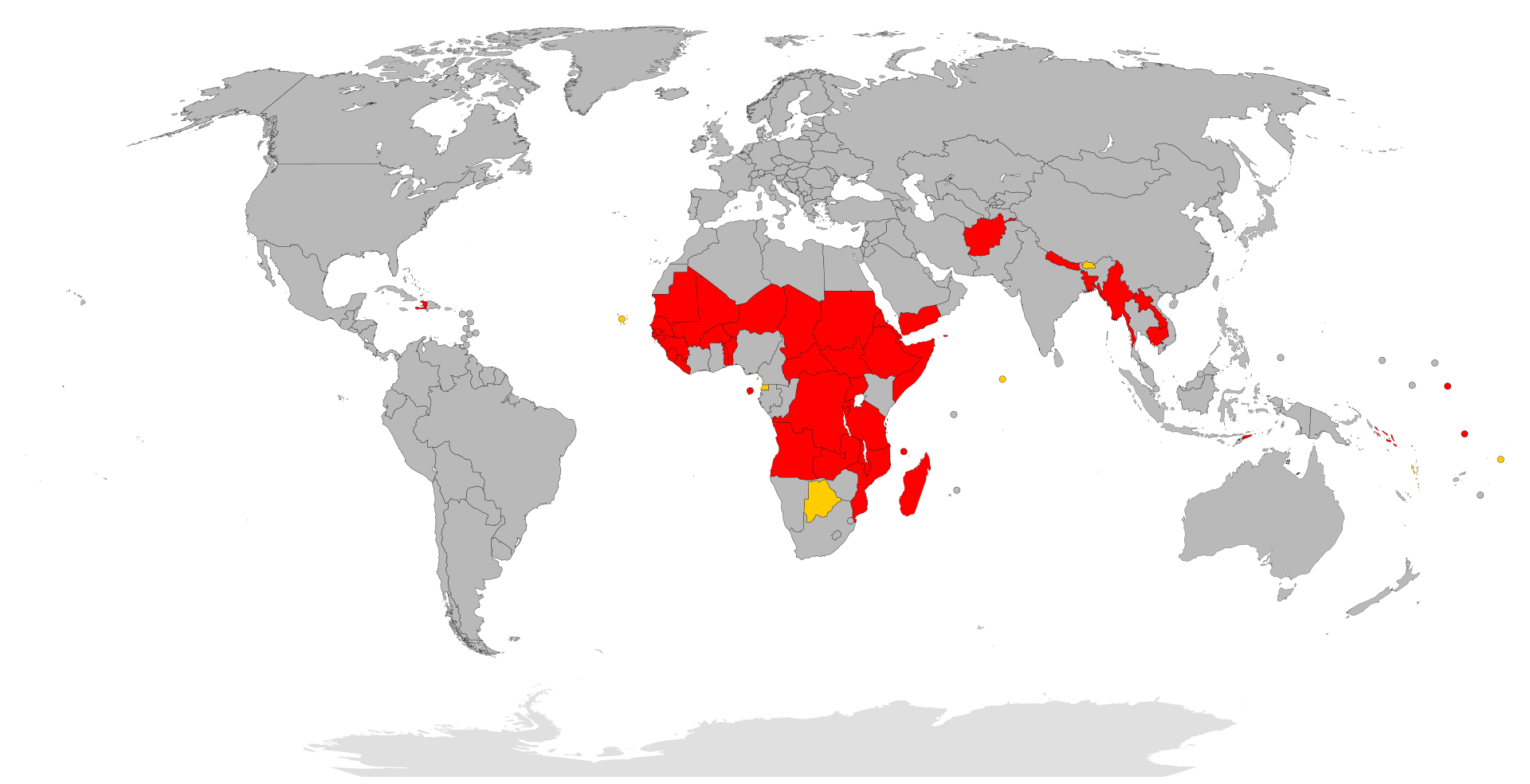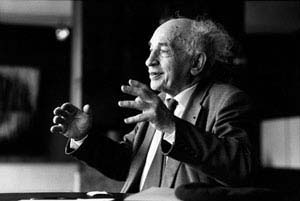
第三世界
Third World

The "Three Worlds" of the Cold War (between 30 April and 24 June 1975)
■First World: Countries aligned with the Western Bloc (i.e., NATO and allies), led by the United States
■Second World: Countries aligned with the Eastern Bloc (i.e., Warsaw Pact, China, and allies), led by the Soviet Union
■Third World: The Non-Aligned Movement, led by India and Yugoslavia, and other neutral countries
☆ 「第三世界」という言葉は、冷戦時代にNATOやワルシャワ条約機構と同盟を結んでいない国々を定義するために生まれた。アメリカ、カナダとその同盟国が 「第一世界」を代表し、ソ連、中国、キューバ、北朝鮮、ベトナムとその同盟国が「第二世界」を代表した。この用語法は、地球上の国々を政治的な区分に基づ いて3つのグループに大別する方法を提供した。意味や文脈が変化してきた複雑な歴史のため、第三世界についての明確な定義や合意された定義はない。
| The term "Third World"
arose during the Cold War to define countries that remained non-aligned
with either NATO or the Warsaw Pact. The United States, Canada and
their allies represented the "First World", while the Soviet Union,
China, Cuba, North Korea, Vietnam, and their allies represented the
"Second World". This terminology provided a way of broadly categorizing
the nations of the Earth into three groups based on political
divisions. Due to the complex history of evolving meanings and
contexts, there is no clear or agreed-upon definition of the Third
World.[1] Strictly speaking, "Third World" was a political, rather than
economic, grouping.[2] Since most Third World countries were economically poor and non-industrialized, it became a stereotype to refer to developing countries as "third-world countries". In political discourse, the term Third World was often associated with being underdeveloped. Some countries in the Eastern Bloc, such as Cuba, were often regarded as Third World. The Third World was normally seen to include many countries with colonial pasts in Africa, Latin America, Oceania, and Asia. It was also sometimes taken as synonymous with countries in the Non-Aligned Movement. In the dependency theory of thinkers like Raúl Prebisch, Walter Rodney, Theotônio dos Santos, and others, the Third World has also been connected to the world-systemic economic division as "periphery" countries dominated by the countries comprising the economic "core".[1] In the Cold War, some European democracies (Austria, Finland, Ireland, Sweden, and Switzerland) were neutral in the sense of not joining NATO, but were prosperous, never joined the Non-Aligned Movement, and seldom self-identified as part of the Third World. Since the dissolution of the Soviet Union and the end of the Cold War, the term Third World has decreased in use. It is being replaced with terms such as developing countries, least developed countries or the Global South. |
「第三
世界」という言葉は、冷戦時代にNATOやワルシャワ条約機構と同盟を結んでいない国々を定義するために生まれた。アメリカ、カナダとその同盟国が「第一
世界」を代表し、ソ連、中国、キューバ、北朝鮮、ベトナムとその同盟国が「第二世界」を代表した。この用語法は、地球上の国々を政治的な区分に基づいて3
つのグループに大別する方法を提供した。意味や文脈が変化してきた複雑な歴史のため、第三世界についての明確な定義や合意された定義はない。 ほとんどの第三世界諸国は経済的に貧しく、非工業化であったため、発展途上国を「第三世界諸国」と呼ぶことがステレオタイプとなった。政治的な言説では、 第三世界という言葉はしばしば低開発国と結びつけられていた。キューバのような東欧圏の国々は、しばしば第三世界とみなされた。第三世界は通常、アフリ カ、ラテンアメリカ、オセアニア、アジアにおける植民地支配の過去を持つ多くの国々を含むと考えられていた。また、非同盟運動に参加する国々と同義とみな されることもあった。ラウル・プレビッシュ、ウォルター・ロドニー、テオトーニオ・ドス・サントスなどの思想家の従属理論においては、第三世界はまた、経 済的「中核」を構成する国々に支配される「周辺」諸国として、世界システム経済分割と結びつけられてきた[1]。 冷戦時代、ヨーロッパの民主主義国家の一部(オーストリア、フィンランド、アイルランド、スウェーデン、スイス)は、NATOに加盟しないという意味で中 立であったが、繁栄しており、非同盟運動に加盟することはなく、第三世界の一部であると自認することはほとんどなかった。 ソビエト連邦が解体し、冷戦が終結して以来、第三世界という言葉は使われなくなった。発展途上国、後発開発途上国、グローバル・サウスといった用語に取って代わられつつある。 |
Etymology Economic classification of the world's countries by the United Nations Conference on Trade and Development: developed economies are highlighted in blue and developing economies (i.e., Third World) are highlighted in red.[3] The demographer, anthropologist, and historian Alfred Sauvy, in an article published in the French magazine L'Observateur, August 14, 1952, coined the term third world (tiers monde), referring to countries that were playing a small role in international trade and business.[4] His usage was a reference to the Third Estate (tiers état), the commoners of France who, before and during the French Revolution, opposed the clergy and nobles, who composed the First Estate and Second Estate, respectively (hence the use of the older form tiers rather than the modern troisième for "third"). Sauvy wrote, "This third world ignored, exploited, despised like the third estate also wants to be something."[5] In the context of the Cold War, he conveyed the concept of political non-alignment with either the capitalist or communist bloc.[6] Simplistic interpretations quickly led to the term merely designating these unaligned countries.[7] |
語源 国連貿易開発会議による世界各国の経済分類:先進国は青、発展途上国(すなわち第三世界)は赤で強調表示されている[3]。 人口学者、人類学者、歴史家のアルフレッド・ソービーは、 1952年8月14日にフランスの雑誌『L'Observateur』に掲載された記事の中で、国際貿易やビジネスにおいて小さな役割を果たしている国々 を指す第三世界(tiers monde)という言葉を作った。 [彼の用法は、フランス革命前と革命中に、それぞれ第一身分を構成する聖職者と第二身分を構成する貴族に対抗したフランスの平民である第三身分 (tiers état)に言及したものであった(それゆえ、「第三」を意味する現代的なtroisièmeではなく、古い形式のtiersが使われている)。ソー ヴィーは「第三身分のように無視され、搾取され、軽蔑されるこの第三世界もまた、何かになりたがっている」と書いている[5]。冷戦の文脈において、彼は 資本主義圏または共産主義圏のいずれとも政治的に非同盟であるという概念を伝えた[6]。単純化された解釈によって、この用語は単にこれらの非同盟の国々 を指すだけにすぐになった[7]。 |
| Related concepts This section needs additional citations for verification. Please help improve this article by adding citations to reliable sources in this section. Unsourced material may be challenged and removed. (August 2023) (Learn how and when to remove this message) Third World vs. Three Worlds Main articles: Three World Model and Three Worlds Theory The "Three Worlds Theory" developed by Mao Zedong is different from the Western theory of the Three Worlds or Third World. For example, in the Western theory, China and India belong respectively to the second and third worlds, but in Mao's theory both China and India are part of the Third World which he defined as consisting of exploited nations. Third Worldism Main article: Third-Worldism Third Worldism is a political movement that argues for the unity of third-world nations against first-world influence and the principle of non-interference in other countries' domestic affairs. Groups most notable for expressing and exercising this idea are the Non-Aligned Movement (NAM) and the Group of 77 which provide a base for relations and diplomacy between not just the third-world countries, but between the third-world and the first and second worlds. The notion has been criticized because providing a fig leaf for human rights violations and political repression by dictatorships.[8][failed verification] Since 1990, this term has been redefined to make it more correct politically. Initially, the term “third world” meant that a nation is “under-developed”.[9] However, today it is replaced by the term “developing". Great Divergence and Great Convergence Many times there is a clear distinction between First and Third Worlds. When talking about the Global North and the Global South, the majority of the time the two go hand in hand. People refer to the two as "Third World/South" and "First World/North" because the Global North is more affluent and developed, whereas the Global South is less developed and often poorer.[10] To counter this mode of thought, some scholars began proposing the idea of a change in world dynamics that began in the late 1980s, and termed it the Great Convergence.[11] As Jack A. Goldstone and his colleagues put it, "in the twentieth century, the Great Divergence peaked before the First World War and continued until the early 1970s, then, after two decades of indeterminate fluctuations, in the late 1980s, it was replaced by the Great Convergence as the majority of Third World countries reached economic growth rates significantly higher than those in most First World countries".[12] Others have observed a return to Cold War-era alignments (MacKinnon, 2007; Lucas, 2008), this time with substantial changes between 1990–2015 in geography, the world economy and relationship dynamics between current and emerging world powers; not necessarily redefining the classic meaning of First, Second, and Third World terms, but rather which countries belong to them by way of association to which world power or coalition of countries, such as the G7, the European Union, OECD; G20, OPEC, N-11, BRICS, ASEAN; the African Union, and the Eurasian Union. |
関連概念 このセクションの検証には追加の引用が必要である。このセクションに信頼できる情報源への引用を追加することで、この記事の改善にご協力いただきたい。 ソースのないものは異議申し立てがなされ、削除される可能性がある。(2023年8月)(このメッセージを削除する方法とタイミングを学ぶ) 第三世界対三世界 主な記事 三世界モデルと三世界理論 毛沢東が展開した「三世界論」は、西洋の三世界論や第三世界論とは異なる。例えば、西洋の理論では、中国とインドはそれぞれ第二世界と第三世界に属するが、毛沢東の理論では、中国もインドも第三世界の一部であり、毛沢東は搾取される国々から構成されると定義した。 第三世界主義 主な記事 第三世界主義 第三世界主義は、第一世界の影響力に対する第三世界の結束と、他国の内政不干渉の原則を主張する政治運動である。この考え方を表明し、実践しているグルー プとして最も注目されているのが、非同盟運動(NAM)と77カ国グループであり、第三世界諸国だけでなく、第三世界と第一、第二世界との関係や外交の基 盤を提供している。この概念は、独裁政権による人権侵害や政治的抑圧のためのイチジクの葉を提供しているとして批判されてきた[8][検証失敗]。 1990年以降、この用語は政治的に正しくなるように再定義されてきた。当初、「第三世界」という用語は、その国が「低開発」であることを意味していた[9]が、今日では「発展途上国」という用語に置き換えられている。 大きな乖離と大きな収束 多くの場合、第一世界と第三世界は明確に区別されている。グローバル・ノースとグローバル・サウスについて語るとき、ほとんどの場合、この2つは手を取り 合っている。人々はこの2つを「第三世界/南」と「第一世界/北」と呼ぶが、これは世界の北がより豊かで発展しているのに対し、世界の南はより発展してお らず、しばしば貧しいからである[10]。 このような思考様式に対抗するために、一部の学者は1980年代後半に始まった世界の力学の変化という考えを提唱し始め、それをグレート・コンバージェン スと呼んだ[11]。20世紀において、大いなる乖離は第一次世界大戦前にピークを迎え、1970年代初頭まで続いたが、その後20年間にわたる不確定な 変動を経て、1980年代後半になると、第三世界の大半の国々が第一世界の大半の国々の経済成長率よりも著しく高い経済成長率に達したため、大いなる収束 に取って代わられた」[12]。 また、今回は1990年から2015年の間に、地理、世界経済、現在の世界大国と新興世界大国との関係力学に大きな変化があり、必ずしも第一、第二、第三 世界という用語の古典的な意味を再定義しているわけではなく、むしろ、G7、EU、OECD、G20、OPEC、N-11、BRICS、ASEAN、アフ リカ連合、ユーラシア連合のような、どの世界大国や国家連合に所属しているかによって、どの国がそれらに属しているかが変わっている、と観察している者も いる(MacKinnon, 2007; Lucas, 2008)。 |
| History Most Third World countries are former colonies. Having gained independence, many of these countries, especially smaller ones, were faced with the challenges of nation- and institution-building on their own for the first time. Due to this common background, many of these nations were "developing" in economic terms for most of the 20th century, and many still are. This term, used today, generally denotes countries that have not developed to the same levels as OECD countries, and are thus in the process of developing. In the 1980s, economist Peter Bauer offered a competing definition for the term "Third World". He claimed that the attachment of Third World status to a particular country was not based on any stable economic or political criteria, and was a mostly arbitrary process. The large diversity of countries considered part of the Third World, from Indonesia to Afghanistan, ranged widely from economically primitive to economically advanced and from politically non-aligned to Soviet- or Western-leaning. An argument could also be made for how parts of the U.S. are more like the Third World.[13] The only characteristic that Bauer found common in all Third World countries was that their governments "demand and receive Western aid," which he strongly opposed. The aggregate term "Third World" was challenged as misleading even during the Cold War period, because it had no consistent or collective identity among the countries it supposedly encompassed. Development aid Main article: Development aid  A map of the world with Less Developed Countries, as designated by the United Nations, highlighted in red and countries formerly considered least developed highlighted in yellow During the Cold War, unaligned countries of the Third World[1] were seen as potential allies by both the First and Second World. Therefore, the United States and the Soviet Union went to great lengths to establish connections in these countries by offering economic and military support to gain strategically located alliances (e.g., the United States in Vietnam or the Soviet Union in Cuba).[1] By the end of the Cold War, many Third World countries had adopted capitalist or communist economic models and continued to receive support from the side they had chosen. Throughout the Cold War and beyond, the countries of the Third World have been the priority recipients of Western foreign aid and the focus of economic development through mainstream theories such as modernization theory and dependency theory.[1] By the end of the 1960s, the idea of the Third World came to represent countries in Africa, Asia, and Latin America that were considered underdeveloped by the West based on several characteristics: low economic development, low life expectancy, high rates of poverty and disease, and others.[7] These countries became the targets for aid and support from governments, NGOs and individuals from wealthier nations. One popular model, known as Rostow's stages of growth, argued that development took place in five stages: traditional society, pre-conditions for take-off, take-off, drive to maturity, and age of high mass consumption.[14] W. W. Rostow argued that "take-off" was the critical stage with which the Third World was struggling, which some argued could be facilitated through foreign aid.[14] Perceived "End of the Third World" Since 1990 the term "Third World" has been redefined in many evolving dictionaries in several languages to refer to countries considered to be underdeveloped economically and/or socially. From a politically correct standpoint the term "Third World" may be considered outdated, which its concept is mostly a historical term and cannot fully address what means by developing and less-developed countries today. Around the early 1960s, the term "underdeveloped countries" occurred and the Third World serves to be its synonym, but after it has been officially used by politicians, 'underdeveloped countries' is soon been replaced by 'developing' and 'less-developed countries,' because the prior one shows hostility and disrespect, in which the Third World is often characterized with stereotypes.[15] The whole 'Four Worlds' system of classification has also been described as derogatory because the standard mainly focused on each nations' Gross National Product.[16] The general definition of the Third World can be traced back to the history that nations positioned as neutral and independent during the Cold War were considered as Third World Countries, and normally these countries are defined by high poverty rates, lack of resources, and unstable financial standing.[17] However, based on the rapid development of modernization and globalization, countries that were used to be considered as Third World countries achieve big economic growth, such as Brazil, India, and Indonesia, which are no longer considered poor nations in the 21st century. The differences among nations of the Third World are continually growing throughout time, and it will be hard to use the Third World to define and organize groups of nations based on their common political arrangements since most countries live under diverse creeds in this era, such as Mexico, El Salvador, and Singapore, which each have their distinct political systems.[18] The Third World categorization becomes anachronistic since its political classification and economic system are distinct to be applied in today's society. Based on the Third World standards, any region of the world can be categorized into any of the four types of relationships among state and society, and will eventually end in four outcomes: praetorianism, multi-authority, quasi-democratic and viable democracy.[19] However, political culture is never going to be limited by the rule and the concept of the Third World can be circumscribed. |
歴史 第三世界のほとんどの国は、かつての植民地である。独立を果たしたこれらの国々、特に小国の多くは、初めて自力で国家や制度を建設するという課題に直面し た。このような共通の背景から、これらの国々の多くは、20世紀のほとんどの期間、経済的には「発展途上国」であったし、現在もその多くは発展途上国であ る。この言葉は今日一般的に、OECD加盟国と同じレベルまで発展しておらず、発展途上にある国々を指す。 1980年代、経済学者のピーター・バウアーは、「第三世界」という用語に対抗する定義を提示した。彼は、特定の国に対する第三世界の地位の付与は、いか なる安定した経済的・政治的基準にも基づいておらず、ほとんど恣意的なプロセスであると主張した。インドネシアからアフガニスタンに至るまで、第三世界の 一部とみなされる国々は、経済的に原始的な国から先進的な国まで、政治的に非同盟の国からソ連寄り、あるいは西側寄りの国まで、実に多様であった。また、 アメリカの一部が第三世界と似ているという議論も成り立つ[13]。 バウアーがすべての第三世界諸国に共通する唯一の特徴は、その政府が「欧米の援助を要求し、受け取っている」ということであり、彼はこれに強く反対した。 第三世界」という総称は、冷戦時代にも誤解を招きかねないものとして問題視された。なぜなら、その総称が包含するとされる国々の間には、一貫した、あるい は集団的なアイデンティティがなかったからである。 開発援助 主な記事 開発援助  国連が指定した後発開発途上国を赤で、かつて後発開発途上国とされていた国々を黄色で示した世界地図。 冷戦時代、第三世界[1]の非同盟諸国は、第一世界と第二世界の両方から潜在的な同盟国として見られていた。そのため、アメリカとソ連は、戦略的に位置す る同盟を得るために経済的・軍事的支援を提供することで、これらの国々につながりを確立するために多大な労力を費やした(例えば、アメリカはベトナムで、 ソ連はキューバで)[1]。冷戦の終結までに、多くの第三世界諸国は資本主義または共産主義の経済モデルを採用し、彼らが選んだ側からの支援を受け続け た。冷戦期とそれ以降を通じて、第三世界の国々は欧米の対外援助を優先的に受け、近代化理論や従属理論といった主流の理論を通じて経済発展の焦点となって きた[1]。 1960年代末までに、第三世界という考え方は、アフリカ、アジア、ラテンアメリカにおいて、経済発展の低さ、平均寿命の低さ、貧困や疾病の発生率の高さ など、いくつかの特徴に基づいて欧米によって未開発とみなされた国々を表すようになった[7]。これらの国々は、政府、NGO、裕福な国の個人からの援助 や支援の対象となった。ロストウの成長段階として知られる一般的なモデルのひとつは、開発は5つの段階で行われると主張した:伝統的社会、離陸のための前 条件、離陸、成熟への推進力、大量消費の時代[14]。W.W.ロストウは、「離陸」が第三世界が苦闘している重要な段階であり、これは対外援助によって 促進されると主張する者もいた[14]。 認識される 「第三世界の終焉」 1990年以降、「第三世界」という用語は、経済的・社会的に未発達とみなされる国々を指す言葉として、様々な言語の辞書で再定義されるようになった。政 治的に正しい立場からは、「第三世界」という用語は時代遅れとみなされるかもしれない。その概念はほとんどが歴史用語であり、今日の発展途上国や後発開発 途上国が意味するものを完全に扱うことはできない。1960年代初頭の頃、「低開発国」という用語が登場し、第三世界はその同義語として機能したが、政治 家によって公式に使用された後、「低開発国」はすぐに「発展途上国」や「後発開発途上国」に取って代わられた。 第三世界の一般的な定義は、冷戦時代に中立・独立国として位置づけられた国々が第三世界諸国とみなされた歴史に遡ることができ、通常、これらの国々は高い 貧困率、資源の欠如、不安定な財政状態によって定義される[17]。 しかし、近代化とグローバリゼーションの急速な発展に基づき、ブラジル、インド、インドネシアのように、かつて第三世界諸国とみなされていた国々が大きな 経済成長を遂げ、21世紀にはもはや貧困国とはみなされなくなっている。 メキシコ、エルサルバドル、シンガポールのように、この時代にはほとんどの国が多様な信条の下で生活しており、それぞれが異なる政治体制を持っている [18]。その政治的分類と経済体制が現代社会で適用するには異なるものであるため、第三世界の分類は時代錯誤となる。第三世界の基準に基づけば、世界の どの地域も、国家と社会の関係の4つのタイプのいずれかに分類することができ、最終的には、プラエトリア主義、多権主義、準民主主義、実行可能な民主主義 という4つの結果に行き着くことになる[19]。しかし、政治文化は決してルールによって制限されることはなく、第三世界の概念は囲い込むことができる。 |
| https://en.wikipedia.org/wiki/Third_World |
|
 Alfred
Sauvy (31 October 1898 – 30 October 1990)[1] was a demographer,
anthropologist and historian of the French economy. Sauvy coined the
term Third World ("Tiers Monde") in reference to countries that were
unaligned with either the Western bloc or the Eastern bloc during the
Cold War.[2][3] Alfred
Sauvy (31 October 1898 – 30 October 1990)[1] was a demographer,
anthropologist and historian of the French economy. Sauvy coined the
term Third World ("Tiers Monde") in reference to countries that were
unaligned with either the Western bloc or the Eastern bloc during the
Cold War.[2][3]Biography Sauvy was born in Villeneuve-de-la-Raho (Pyrénées-Orientales) in 1898 to a family of Catalan wine-growers, and educated at the École Polytechnique. After graduating, he worked at Statistique Générale de France until 1937. He took part in the X-Crise Group. From 1938, he was economic advisor to Minister of Finance Paul Reynaud until the Second World War broke out in 1939. Under the Nazi occupation, Sauvy contributed to the Bulletins rouge-brique, a government-sanctioned periodical. After the war, Charles de Gaulle offered to appoint him to the position of General Secretary for Family and Population, but Sauvy preferred to devote himself to demographics. From 1940-1959, he taught at the Institut d’études politiques (IEP) and was Professor of Social Demography at the Collège de France. He became director of INED (National Institute of Demographic Studies) and simultaneously represented France at the commission of Statistics and Population of the United Nations. He was a member of the American Academy of Arts and Sciences (1973) and the American Philosophical Society (1974).[4][5] He wrote for Le Monde until his death in October 1990. Key ideas Writing in 1949, Sauvy described potential overpopulation as a 'false problem' and argued against attempts at global population control. He suggested examining countries on a case-by-case basis to determine whether they lack the raw materials and natural resources that can support a larger population. Otherwise, he thought that we run the risk of underpopulating a country that could support a much larger population[citation needed] Sauvy coined the term 'Third World' in an article published in the French magazine, L'Observateur on August 14, 1952. He wrote: "...car enfin, ce Tiers Monde ignoré, exploité, méprisé comme le Tiers Etat, veut lui aussi, être quelque chose" "...because at the end, this ignored, exploited, scorned Third World, like the Third Estate, wants also, to become something".[6] Sauvy coined Third World by analogy with the Third Estate and the above quote is a paraphrase of Sieyès's famous sentence about the Third Estate during the French Revolution. Works 1958 De Malthus à Mao-Tsé-Toung (Collection Thémis -Sciences sociales) 1977 Coût et valeur de la vie humaine—Paris : Hermann, 210 p. 1980 La machine et le chômage : les progrès techniques et l'emploi—Paris : Dunod/Bordas, 320 p. 1984 Le travail noir et l'économie de demain—Paris : Calmann-Lévy, 304 p. 1985 De la rumeur à l'histoire—Paris : Dunod, 304 p. 1990 La terre et les hommes : le monde où il va, le monde d'où il vient—Paris : Economica, 187 p. |
 ア
ルフレッド・ソーヴィー(Alfred Sauvy、1898年10月31日 -
1990年10月30日)[1]は人口学者、人類学者、フランス経済史家である。冷戦時代、西側ブロックや東側ブロックのどちらにも属さない国々を指す言
葉として、第三世界(「Tiers Monde」)という言葉を生み出した[2][3]。 ア
ルフレッド・ソーヴィー(Alfred Sauvy、1898年10月31日 -
1990年10月30日)[1]は人口学者、人類学者、フランス経済史家である。冷戦時代、西側ブロックや東側ブロックのどちらにも属さない国々を指す言
葉として、第三世界(「Tiers Monde」)という言葉を生み出した[2][3]。経歴 ソーヴィーは1898年、ヴィルヌーヴ・ド・ラ・ラホ(ピレネー=オリエンタル地域圏)のカタロニア人ワイン生産者の家に生まれ、エコール・ポリテクニー クで教育を受けた。卒業後、1937年までStatistique Générale de Franceで働く。エックス・クライズ・グループに参加した。1938年からは、1939年に第二次世界大戦が勃発するまで、ポール・レイノー大蔵大臣 の経済顧問を務めた。 ナチス占領下では、政府公認の定期刊行物『Bulletins rouge-brique』に寄稿した。戦後、シャルル・ド・ゴールから家族・人口担当書記長への任命を打診されたが、ソーヴィーは人口統計学に専念することを希望した。 1940年から1959年まで政治学院(IEP)で教鞭をとり、コレージュ・ド・フランスでは社会人口学の教授を務めた。 INED(国立人口学研究所)の所長となり、同時にフランス代表として国連の統計・人口委員会に参加した。アメリカ芸術科学アカデミー会員(1973年)、アメリカ哲学協会会員(1974年)[4][5]。1990年10月に亡くなるまでル・モンド紙に寄稿していた。 主な思想 1949年に執筆したソーヴィーは、潜在的な人口過剰を「誤った問題」とし、世界的な人口抑制の試みに反対を唱えた。彼は、より多くの人口を支えることが できる原材料や天然資源が不足しているかどうかを判断するために、ケースバイケースで国々を調査することを提案した。そうでなければ、より多くの人口を養 うことができる国でも人口不足に陥る危険性があると彼は考えた[要出典]。 ソーヴィーは、1952年8月14日にフランスの雑誌『L'Observateur』に掲載された記事の中で、「第三世界」という言葉を作り出した。彼はこう書いている: ...最終的には、無視され、搾取され、国家と同じように脅かされている『第三世界』は、自分もそうでなければならない。 「最後には、この無視され、搾取され、蔑まれた第三世界も、第三国と同じように、何かになることを望むのだから」[6]。 ソーヴィーは、第三身分の類推から第三世界という造語を生み出し、上記の引用は、フランス革命時の第三身分に関するシエスの有名な一文の言い換えである。 著作 1958年 マルサスから毛沢東へ(テミス社会科学全集) 1977 Coût et valeur de la vie humanaine- パリ : ヘルマン, 210 p. 1980 機械と労働 : 技術の進歩と雇用-パリ : デュノ/ボルダス, 320 p. 1984 Le travail noir et l'économie de demain-Paris : Calmann-Lévy, 304 p. 1985 De la rumeur à l'histoire-Paris : Dunod, 304 p. 1990 La terre et les hommes : le monde où il va, le monde d'où il vient-Paris : Economica, 187 p. |
リ ンク
文 献
そ の他の情報
Copyleft, CC, Mitzub'ixi Quq Chi'j, 1996-2099
☆
 ☆
☆